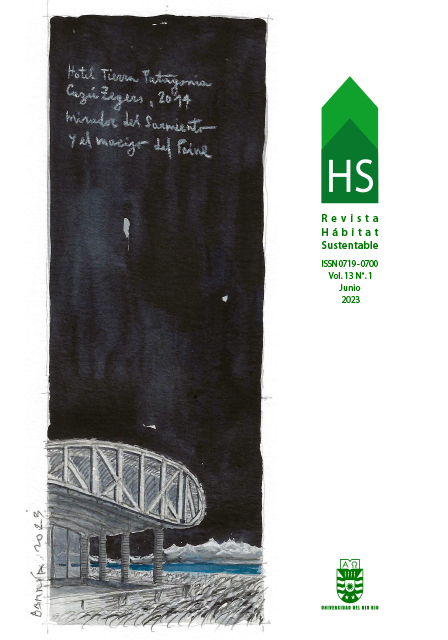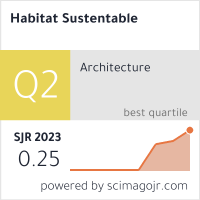Mejora del desempeño térmico de colegios en la Región Altoandina del Perú. El caso del “módulo prefabricado aula tipo heladas - PRONIED”
DOI:
https://doi.org/10.22320/07190700.2023.13.01.05Palabras clave:
diseño bioclimático, estrategias pasivas, desempeño térmico, simulación energéticaResumen
Frente al déficit cualitativo y cuantitativo de infraestructura educativa en las zonas rurales altoandinas del Perú, el estado peruano ha venido invirtiendo y apostando en los últimos años en soluciones modulares, buscando la eficiencia en los procesos constructivos. La propuesta específica, con énfasis en el diseño bioclimático, es el “Módulo Prefabricado Aula tipo Heladas”; sin embargo, los usuarios han venido manifestando una falta de confort en estos nuevos ambientes. El presente estudio muestra el desarrollo de mediciones realizadas en un módulo construido, que permitieron la calibración y validación del modelo en un software de simulación, con el fin de proponer mejoras en el diseño que aporten a las futuras construcciones. Tomando como referencia el modelo de confort térmico adaptativo, se comprobó que las temperaturas interiores estaban por debajo de la zona de confort en las primeras horas de la mañana y muy por encima cerca del mediodía, alrededor de 6 ºC y 7 ºC respectivamente. Con la aplicación de estrategias bioclimáticas complementarias se logró mejorar considerablemente las condiciones térmicas interiores, aunque no lo suficiente para alcanzar la zona de confort en las primeras horas de la mañana; ello debido a que las temperaturas exteriores nocturnas son muy bajas, a que el edificio está deshabitado toda la noche, a la ausencia de masa térmica en la envolvente y a que no cuenta con sistemas solares activos ni de climatización artificial.
Descargas
Citas
ASHRAE Standard (2017). Standard 55-2017 Thermal environmental conditions for human occupancy. Ashrae: Atlanta, GA, USA.
CHUI BETANCUR, H. N., HUAQUISTO RAMOS, E., QUISPE, G. B., CANALES GUTIÉRREZ, Á. & CALATAYUD MENDOZA, A. P. (2022). Características de la arquitectura vernácula en zonas altoandinas de Perú. Una contribución al estudio del mundo rural. Cuadernos de Vivienda y Urbanismo, 15, 21-21. DOI: https://doi.org/10.11144/Javeriana.cvu15.cavz
BOS, M. S., GANIMIAN, A. J., VEGAS, E. & ALFONSO M. (2014). Brief Nº13: Perú en PISA 2012 logros y desafíos pendientes. BID. Retrieved from: https://repositorio.minedu.gob.pe/handle/20.500.12799/3814
BURGA, J. (2010). Arquitectura vernácula peruana: un análisis tipológico. Colegio de Arquitectos del Perú.
GENG, Y., JI, W., LIN, B. & ZHU, Y. (2017). The impact of thermal environment on occupant IEQ perception and productivity. Building and Environment, 121, 158-167. DOI: https://doi.org/10.1016/j.buildenv.2017.05.022
GIVONI, B. (1992). Comfort, climate analysis and building design guidelines. Energy and buildings, 18(1), 11-23. DOI: https://doi.org/10.1016/0378-7788(92)90047-K
HAVES, P., RAVACHE, B., FERGADIOTTI, A., KOHLER, C. & YAZDANIAN, M. (2019). Accuracy of HVAC Load Predictions: Validation of EnergyPlus and DOE-2. Using an Instrumented Test Facility. In Proceedings of Building Simulation. DOI: https://doi.org/10.26868/25222708.2019.211268
KÜKRER, E. & ESKIN, N. (2021). Effect of design and operational strategies on thermal comfort and productivity in a multipurpose school building. Journal of Building Engineering, 44, 102697. DOI: https://doi.org/10.1016/j.jobe.2021.102697
MANZANO-AGUGLIARO, F., MONTOYA, F. G., SABIO-ORTEGA, A. & GARCÍA-CRUZ, A. (2015). Review of bioclimatic architecture strategies for achieving thermal comfort. Renewable and Sustainable Energy Reviews, 49, 736-755. DOI: https://doi.org/10.1016/j.rser.2015.04.095
MAZZEO, D., MATERA, N., CORNARO, C., OLIVETI, G., ROMAGNONI, P. & DE SANTOLI, L. (2020). EnergyPlus, IDA ICE and TRNSYS predictive simulation accuracy for building thermal behaviour evaluation by using an experimental campaign in solar test boxes with and without a PCM module. Energy and Buildings, 212, 109812. DOI: https://doi.org/10.1016/j.enbuild.2020.109812
MOLINA, J. R., LEFEBVRE, G., ESPINOZA, R., HORN, M. & GÓMEZ, M. M. (2021). Bioclimatic approach for rural dwellings in the cold, high Andean region: A case study of a Peruvian house. Energy and Buildings, 231, 110605. DOI: https://doi.org/10.1016/j.enbuild.2020.110605
Programa Nacional de Infraestructura Educativa, PRONIED del Ministerio de Educación, MINEDU (2021). Ficha de Homologación de Módulo Prefabricado Aula tipo Heladas. Retrieved from: https://www.gob.pe/institucion/pronied/campa%C3%B1as/4440-fichas-de-homologacion-de-modulos-prefabricados
SÁEZ, E., & CANZIANI, J. (2020). Vernacular architecture and cultural landscapes in the Sondondo Valley (Peru). The International Archives of Photogrammetry, Remote Sensing and Spatial Information Sciences, 44(M1), 175-180. DOI: https://doi.org/10.5194/isprs-archives-XLIV-M-1-2020-175-2020
SZOKOLAY, S. (2012). Introduction to architectural science. Routledge. DOI:
https://doi.org/10.4324/9780080473130
TORRES PUÑEZ, C. M. (2021). Construyendo la educación: infraestructura como determinante del rendimiento académico en el Perú 2000-2015. [Thesis for the degree of Economist, Universidad de Lima]. Retrieved from: https://hdl.handle.net/20.500.12724/13874
TREMBLAY, J. C. & AINSLIE, P. N. (2021). Global and country-level estimates of human population at high altitude. Proceedings of the National Academy of Sciences, 118(18), e2102463118. DOI: https://doi.org/10.1073/pnas.2102463118
VIDAL, J. P. (2014). Las ocho regiones naturales del Perú. Terra Brasilis Revista da Rede Brasileira de História da Geografia e Geografia Histórica, (3). DOI: https://doi.org/10.4000/terrabrasilis.1027
WARGOCKI, P., PORRAS-SALAZAR, J. A. & CONTRERAS-ESPINOZA, S. (2019). The relationship between classroom temperature and children’s performance in school. Building and Environment, 157, 197-204. DOI: https://doi.org/10.1016/j.buildenv.2019.04.046
WIESER, M., RODRÍGUEZ-LARRAÍN, S. & ONNIS, S. (2021). Bioclimatic strategies for high altitude tropical cold climate. Prototype validation in Orduña, Puno, Perú. Estoa. Revista de la Facultad de Arquitectura y Urbanismo de la Universidad de Cuenca, 10(19), 09-19. DOI: https://doi.org/10.18537/est.v010.n019.a01
ZOMORODIAN, Z. S., TAHSILDOOST, M. & HAFEZI, M. (2016). Thermal comfort in educational buildings: A review article. Renewable and Sustainable Energy Reviews, 59, 895-906. DOI: https://doi.org/10.1016/j.rser.2016.01.033
Descargas
Publicado
Cómo citar
Número
Sección
Licencia
Derechos de autor 2023 Martin Wieser, Antonio Garaycochea, Varinia Prada

Esta obra está bajo una licencia internacional Creative Commons Atribución-CompartirIgual 4.0.
El contenido de los artículos que se publican en cada número de Hábitat Sustentable, es responsabilidad exclusiva de los autores y no representan necesariamente el pensamiento ni comprometen la opinión de la Universidad del Bío-Bío.
Los autores/as conservarán sus derechos de autor y garantizarán a la revista el derecho de primera publicación de su obra, el cuál estará simultáneamente sujeto a la Licencia de Reconocimiento de Creative Commons CC BY-SA que permite a otros compartir-copiar, transformar o crear nuevo material a partir de esta obra con fines no comerciales, siempre y cuando se reconozcan la autoría y la primera publicación en esta revista, y sus nuevas creaciones estén bajo una licencia con los mismos términos.











 Programa de Información Científica/Concurso Fondos de Publicación de Revistas Científicas 2018/ Proyecto Mejoramiento de Visibilidad de Revistas UBB (Código:FP180007)
Programa de Información Científica/Concurso Fondos de Publicación de Revistas Científicas 2018/ Proyecto Mejoramiento de Visibilidad de Revistas UBB (Código:FP180007) 





